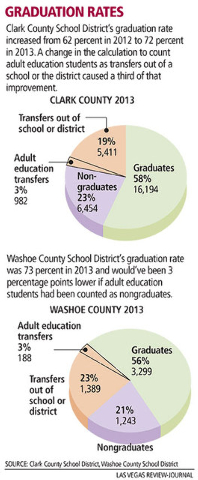Nevada graduation rate rises as students excluded from count
Call her the invisible student.
Citlali Galvan is still attending class but — like her three older siblings — won’t graduate from high school.
The failure of the Clark County 18-year-old, who attended Basic High School before enrolling in adult education, won’t register on the barometer most commonly used to gauge the quality of public schools: the high school graduation rate.
Galvan and more than 1,000 other struggling seniors are being excluded from Nevada’s graduation rate calculation under direction from the Nevada Department of Education.
The practice is “exploiting a federal loophole” to inflate schools’ graduation rates and also is “against federal law,” contends Daria Hall, director of K-12 policy for The Education Trust in Washington, D.C., a nonprofit promoting academic achievement.
“I think there are real legitimate concerns here,” Hall told the Review-Journal last month.
She emphasized that the practice is at odds with the federally mandated way of calculating the graduation rate, a method first instituted for the class of 2011 by the U.S. Department of Education.
In Nevada, the ripples of the new graduation rate formula and how the state Department of Education chose to handle it weren’t evident until January’s release of the state’s 2013 graduation rate, which jumped from 63 percent in 2012 to 71 percent. The increase was largely due to the Clark County School District’s implementation of the state’s 2011 directive to omit adult education students.
School districts were told to treat students who transfer out of high schools to adult education programs as if they have left Nevada. Previously, schools labeled such students nongraduates, which hurt their graduation rates.
Now, schools are bolstering their graduation rates by removing that group from the count, doing so under the rationale that the students are still in diploma-granting programs.
However, those students had only a 3 percent success rate in earning diplomas in 2013, according to a count of 1,170 seniors who had transferred into adult-education programs in the state’s largest districts, Clark and Washoe.
The state doesn’t track the total number of adult education transfers, but does report the number of diplomas awarded to would-be seniors in adult education. Only 37 of Nevada’s adult education students earned diplomas within four years out of at least 1,170 transfers belonging to the 2013 class.
Clark County’s 2013 graduation rate rose 10 percentage points to 72 percent, playing a great part in hoisting the state’s graduation rate 8 percentage points.
That kind of jump “you don’t see without a change to the calculation,” Hall said.
SMALL CHANGE, BIG IMPACT
Of Clark County’s 10-point graduation rate jump, only 4 percentage points can be attributed to actually graduating more students. In 2013, the district recorded 900 more seniors earning diplomas than in 2012.
However, students transferring out of schools or the district accounted for 6 percentage points of the improvement. While half of those students were found to have actually left, the seemingly small tweak in the calculation had a big impact. Omitting adult education transfers increased the graduation rate by 3 percentage points, causing a third of Clark County’s graduation-rate improvement.
Clark County Superintendent Pat Skorkowsky anticipated that happening in a Dec. 9, 2013, letter to State Superintendent of Public Instruction Dale Erquiaga asking that the change apply to all adult education transfers. That would impact “individual (Clark County) schools’ rates significantly” and “create upward movement for the state graduation rate, too,” Skorkowsky wrote.
Many adult education students have a slim chance of earning a diploma, however, and are advised to pursue a certificate of General Educational Development, as Galvan is doing. GED students also are omitted from the graduation rate.
“This approach is inconsistent with our regulations,” said U.S. Department of Education spokesman David Thomas when questioned about the legality of removing GED students from the equation.
Any state found in violation would be contacted to determine a remedy, Thomas said.
Federal regulations state that a student who enrolls in a “GED program, or leaves school for any other reason may not be counted as having transferred out.” Such students must be counted as failures, even if they receive GED certificates.
“I wanted to get a diploma,” said Galvan, but adult-education advisers “said I need too many credits and recommended a GED.” Galvan did not know a GED certificate is not accepted from freshmen by four-year colleges.
The GED Testing Service reports an average of 1,800 Nevada students ages 16 to 18 take the GED test every year. Those students should be counted against schools under federal law, according to Hall and Maria Ferguson, executive director of the Center on Education Policy at George Washington University.
“The reason we have the new graduation rate in place is because there’s a history of creative math that inflated graduation rates,” said Phillip Lovell, vice president of the Washington, D.C.-based Alliance for Excellent Education, which promotes responsible school reform.
The U.S. Department of Education mandated the graduation rate calculation so there would be a universal calculation for school success, a clear picture of how students are doing from school to school.
Nevada officials have found a way to muddy the waters, according to policy experts from three national education organizations who question the legality of excluding students seeking GED certificates.
“It’s my understanding that we are using the federal cohort rules,” Erquiaga said last month, emphasizing that he is following practices in place before Gov. Brian Sandoval hired him in August. “If we’re using a rule that the federal government will not accept, I clearly want to know that.”
Nevada’s graduation rate handbook for the class of 2013 does tell districts to keep GED students in the calculation and count them against schools as nongraduates, said Julian Montoya, Nevada’s assistant director of assessments, program accountability and state academic standards.
While the handbook and state law say one thing, districts are receiving the opposite message from state Department of Education staff.
Erquiaga sent a Dec. 12, 2013, email to Skorkowsky allowing the district’s request to count a student as a transfer out if they “successfully enrolled in adult education.” No distinction is made for GED students.
Washoe County School District received the same directive from the state: All adult-education transfers are to be taken off the books, according to a data analyst.
“The state isn’t even following its own law,” Hall said.
vanishING INTO ADULT EDUCATION
Before the new graduation rate calculation came into play for the class of 2011, states calculated their graduation rates in a variety of ways, often using the number of seniors at the beginning of the year to calculate what percentage earned diplomas by the summer.
Students who dropped out before becoming seniors weren’t captured.
Under the 2011 federal system, schools use a simple calculation that tracks students through four years of high school. Divide the number of students graduating with a “regular high school diploma” by the freshman enrollment for that class.
Students who transferred in from another school are factored in. Students who don’t earn a diploma in four years — whether they dropped out, didn’t meet requirements or earned a GED certificate — are counted as nongraduates, remaining in the total class count and dragging down the graduation rate.
Schools can remove transfers from their books only if they leave the country, die or enroll in another “program that culminates in the award of a regular high school diploma.”
Nevada’s adult education programs meet the diploma requirement because they offer the state’s Adult High School Diploma, which requires the same credits — with the exception of 2.5 physical education credits — and high school exit exams, according to Robert Henry, Clark County’s director of adult education.
“They’re still earning credit toward a high school diploma,” Henry said.
However, not one of the 982 Clark County high school seniors who transferred into adult education earned an adult high school diploma within four years in 2013, according to district and state records. If those unsuccessful students had been factored into the calculation, the district’s graduation rate would have been 69 percent, down 3 percentage points from what was reported.
The district didn’t track adult education transfers for the classes of 2011 and 2012, but not one transfer earned an adult high school diploma on time, according to reports produced by the Nevada Department of Education.
Omitting nearly a thousand students from the graduation rate who don’t earn diplomas on time, if at all, shouldn’t be embraced by any education system truly focused on student success, said Jessica Cardichon, director of federal advocacy at the Alliance for Excellent Education. Doing so means the student group isn’t tracked by the graduation rate or in data submitted to the federal government.
“Who’s to say they’re succeeding, that transferring them is working?” Cardichon asked. “They need to be followed.”
On Jan. 29, the Review-Journal asked Clark County School District officials how many of the 982 adult education students who should have been seniors in 2013 received diplomas or GED certificates. District officials said that information isn’t tracked and would take time to calculate.
More than a month later, the information still hasn’t been provided.
Officials point to the limitations of their student information system, which is being replaced this fall.
Nevada is “running the risk of sweeping students who most need our help under the rug,” Hall said.
Other states haven’t followed Nevada’s lead.
Oregon also has an adult high school diploma adhering to the same credit requirements as a standard diploma. But Oregon includes adult education transfers in its graduation rate to make sure “each and every student” is tracked, not “masked,” said Crystal Greene, spokeswoman for the Oregon Department of Education.
Oregon counts adult education students as failures, regardless of whether they earn diplomas on time.
“We want to make sure a diploma means a certain thing,” she said.
A DUMPING GROUND?
Nevada’s practice also could tempt school officials to funnel struggling students into adult education programs. Fail or succeed, the student would be off their books.
“That’s our concern,” Montoya said. “We don’t want adult education to be a dumping ground.”
Erquiaga said the state will soon be able to see the number of students reported as adult education transfers because of a new statewide student-tracking system. His department will make sure there is no surge in transfers, preventing a repeat of what happened in Florida, he said.
Florida also used to remove adult education transfers from school rolls as if they didn’t exist. Some counties, such as Seminole County, took advantage of that. In Seminole, the 2009 graduation rate was 92 percent. But factor in the students in adult education, and Seminole’s graduation rate plummets to 78 percent.
“Schools and districts are always wanting their graduation rates to look the best they can. They also want the best for their individual students,” said Jane Fletcher, Florida Department of Education’s assistant deputy commissioner for accountability, research and measurement.
Now that Clark County School District officials are aware of the loophole, to what extent will failing students be encouraged to transfer to adult education?
“That question is certainly a good one,” said Robert Henry, the Clark County School District’s adult education director.
He noted that he hasn’t seen an influx of transfers this school year.
“I really don’t anticipate high schools counseling students out. I really do believe our high schools have a commitment to their students.”
Henry said all transferred students are interviewed to make sure they weren’t forced out of their high schools.
Florida put an end to the calculation method being abused by schools, starting with the 2011 class. The state now counts GED students as failures.
Other adult education transfers are counted as nongraduates by their home high school, unless they earn a diploma within four years. Those successful students are counted as graduates. They no longer are stricken from the rolls, as is being done in Nevada, because it’s “clear” that can’t be done, Fletcher said.
“That’s all in the federal requirements,” she said.
Contact reporter Trevon Milliard at tmilliard@reviewjournal.com or 702-383-0279.






























